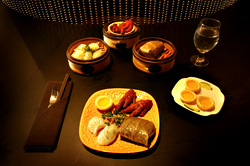You may not associate the words “power lunch” with “dim sum,” but Seattle’s politicos now do. On my lunchtime visit to O’Asian Kitchen, the new Chinese restaurant on Fifth Avenue and Columbia Street, my tablemates name-checked two muckety-mucks in Seattle politics in the first 10 minutes, while I simply noted more suits than I’ve ever seen congregated in one room in this town. For the moment, O’Asian is the perfect place to broker deals over siu mai and braised chicken feet, because it’s tucked so far back at the back of the Bank of America’s mezzanine-level plaza that the casual passerby would never know it was there.
But O’Asian’s high-end dim sum—high end, that is, at $20 a person—is definitely worth an expedition. Now, there’s nothing I love more than the glorious overwhelm of a Sunday morning at one of the city’s plebian dim sum hangars, fending off dumpling pushers and shouting to be heard over surrounding 10-tops. Managing partners Janet Lau and Walter Kwan own one of those places—the Bellevue favorite, Top Gun—but they have long felt a higher calling: to introduce Seattle to the kind of upscale Chinese restaurants you’ll find in Vancouver and San Francisco, with business-class dim sum during the day and first-class dinner fare at night.
I could spend paragraphs talking about designer Hank Lo’s decor, which is Japanese in its spare, clean lines and Chinese in its sumptuous golds, blacks, and reds. The seat cushions are plump, the tables polished until they reflect the light. Were it in Belltown, O’Asian would be filled every night with scoop-necked shirts and gel-hardened hair.
Though you’re eating off square, artisan-crafted ceramic plates, the dim sum procedure is customary. Women (dressed in catering tuxes) push around carts filled with steamers (polished bamboo, not dented aluminum) whose contents are so varied that you’ll curse the heavens for making your stomach smaller than it should be. Every piece of it is beautiful. Triangular spinach-and-shrimp dumplings resemble emeralds suspended in milky glass. A triple-size shrimp and crab dumpling floats in chicken broth in a tiny pumpkin-shaped bowl. Daikon cakes, cut into tiny cubes, are tossed with cucumbers and chiles. Even the steamed barbecued pork buns are shaped like smooth white lozenges instead of exploded cotton balls. All the classics are here, as well as pan-Asian items like Vietnamese shrimp paste molded around sugar cane and sushi-esque rice-and-vegetable rolls wrapped in seaweed and deep-fried.
When it comes to flavor, the chefs’ studious refinement sometimes approaches oversimplification, the gut appeal of some ingredients washed out (for example, the normally pungent black bean sauce on the stuffed tofu has no presence, and the shrimp in translucent-skinned ha gow dumplings, no seasoning). With a few exceptions, however, the cooks, overseen by Wai King Huen, master the slippery, creamy, chewy, flaky, delicate textures that Chinese foodies scrutinize more intensely than Western ones do.
At night, with no streetfront visibility or hungry suits around, O’Asian disappears into the concrete monoliths and vacant streets of downtown. Even with a tempting menu, it’s hard to see how the restaurant is going to attract an evening crowd. The few customers in the main room are a’sea in empty space, tended to by slick but underoccupied waiters.
At this time of day, the chefs are aiming for what they call “regional Chinese fare,” which means a mix of fancified Chinese-American standards like Mongolian beef, more traditional Chinese preparations such as steamed lobster with egg white and Chinese wine, and fusiony dishes made with Chinese techniques and American tastes in mind, such as free-range, deep-fried chicken in a strawberry sauce.
The entrées, which average $18 apiece and are massive in scale, are served family style, with rice and vegetables sold separately. Though my friend and I only ordered two entrées and a side of vegetables, we could easily have fed three people, and with an extra appetizer, probably four.
As with the dim sum, the cooks pulled their punches when it came to flavor, lavishing care instead on mouthfeel. Sauteed baby bok choy was perfectly crisp-tender, with an appetizing wok char, that hint of smoky savoriness delivered by a blazingly hot pan. Our Cheng Do Fish Pot, served in a grandiose terrine, had a thin, only moderately spicy broth instead of the fragrant, sometimes numbing soups this Sichuanese region is famous for. But floating in the broth were just-tender fish, slightly crunchy pickled cabbage, soft radish, and frilly wood ear. And the Peking duck, served with shell-shaped steamed buns and plum sauce, was perfectly proper, the skin all crispiness, the breast meat underneath all succulence. We savored each bite in silence.






